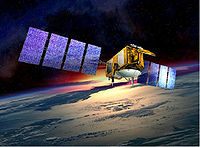
Photo from wikipedia
The Weather Research and Forecasting (WRF) model has been successfully used in weather prediction, but its ability to simulate precipitation over areas with complex topography is not optimal. Consequently, WRF… Click to show full abstract
The Weather Research and Forecasting (WRF) model has been successfully used in weather prediction, but its ability to simulate precipitation over areas with complex topography is not optimal. Consequently, WRF has problems forecasting rainfall events over Chilean mountainous terrain and foothills, where some of the main cities are located, and where intense rainfall occurs due to cutoff lows. This work analyzes an ensemble of microphysics schemes to enhance initial forecasts made by the Chilean Weather Agency in the front range of Santiago. We first tested different vertical levels resolution, land use and land surface models, as well as meteorological forcing (GFS/FNL). The final ensemble configuration considered three microphysics schemes and lead times over three rainfall events between 2015 and 2017. Cutoff low complex meteorological characteristics impede the temporal simulation of rainfall properties. With three days of lead time, WRF properly forecasts the rainiest N-hours and temperatures during the event, although more accuracy is obtained when the rainfall is caused by a meteorological frontal system. Finally, the WSM6 microphysics option had the best performance, although further analysis using other storms and locations in the area are needed to strengthen this result.
Journal Title: Atmosphere
Year Published: 2018
Link to full text (if available)
Share on Social Media: Sign Up to like & get
recommendations!